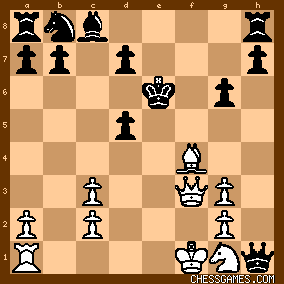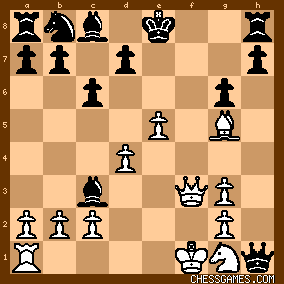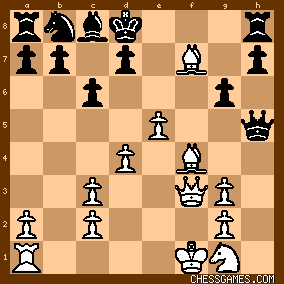|
< Earlier Kibitzing · PAGE 2 OF 2 ·
Later Kibitzing> |
| Sep-10-16 | | gofer: Black has taken the bait. Qh1 is hopelessly out of the action where as white
has six pieces ready to attack the hapless king on e8. "Six pieces???" I hear
you question. Yes, Ra1, Bc4, Bf4, Qf3 and the little fellows on d4 and e5... <12 Bxf7+ ...>
12 ... Kf8
13 Bg5 mating
12 ... Ke7
13 Bg5+ mating
12 ... Kd8
13 Bg5+ Kc7
14 bxc3 or Qf6 
<12 ... Kxf7>
<13 e6+ ...>
Another lamb to the slaughter...
13 ... Kf8
14 Bd6++ mating
13 ... Kg8
14 Bd6 mating
13 ... Kg7
14 Be5+ mating
13 ... Ke8
14 Bd6 dxe6
15 Qf6 
13 ... dxe6
14 Bd6+ Kg7 (Kg8 Qf8# or Ke8 15 Qf6  as above)
15 Be5+ Kg8 as above)
15 Be5+ Kg8
16 Qf6 Qh6
17 Qxh8+ Kf7
18 Qxc8 
<13 ... Kxe6>
<14 d5+ ...>
Oh yeah!!! The sacrifices keep coming and black has to keep accepting them! 14 ... Ke7
15 e6+ 
14 ... Kf8/Kf7/Kf6
15 Bd6+ 
<14 ... cxd5>
<15 bxc6 ...>

click for larger viewNow this bit is four moves into a Saturday puzzle, so I am skating on thin
ice, but it all looks horrible for black at any point we can bring Ra1 into the game with check, which will either force the king onto the f file
for a nasty discover check Bd6+ forcing him into a corner where mate will
"easily" follow...
or
if black tries <15 ... d6> the queen scoops up Pd5 and Pd6... or
if black tries <15 ... Qh5> the discovered check scoops Qh5! All black's pieces are horribly misplaced.
~~~
Hmmm, okay, now I am intrigued. Does <14 d5+> hold water?!?!? <Once> what does Herr Fritz feel about it?! |
|
| Sep-10-16 | | agb2002: White is a rook down.
Black threatens Bxd4.
The attempt to trap the black queen with bxc3, Kf2, Rf1, Nh3 seems to be too slow due to 12.bxc3 d5 13.exd6 O-O (I assume this is posdible) 14.Kf2 Qh5 and Black controls g4. Another option is 12.Bxf7+, trying to expose the black king: A) 12... Kxf2 13.Bg5+ (to control the escape square d8) A.1) 13... Ke6 14.Qf6+ Kd5 15.Qd6+ Ke4 (15... Kc4 16.Qc5#) 16.bxc3 and mate soon. For example, 16... Kf5 17.Qf6+ Ke4 (17... Kg4 18.Qf4+ Kh5 19.g4#) 18.Re1+ Kd5 19.Qd6+ Kc4 20.Qc5#. A.2) 13... Ke8 14.Qf6 Bb4 15.Qxh8+ Bf8 (15... Kf7 16.Qxc8 and White will win decisive material) 16.Kf2 with the idea Rf1, Ke1, Qxf8# looks very good in spite of the piece down. For example, 16... Qh5 17.Nh3 d5 18.Rf1 Bxh3 19.Ke1 Qxg5 20.Qxf8+ Kd7 21.Rf7+ Ke6 22.Qe8+ Qe7 23.Qxe7#. A.3) 13... Kg7 14.Qf6+ Kg8 15.Qd8+ Kf(g)7 16.Qe7+ Kg8 17.Bf6 and mate in three. A.4) 13... Kg8 14.Be7
A.4.a) 14... Kg7 15.Qf6+ Kh6 (15... Kg8 16.Qf8#) 16.Qxh8 with many threats (Qf8+, Qxc8, bxc8) looks winning. For example, 16... Bxd4 17.Qf8+ Kh5 18.g4+ Kxg4 19.Qf3#. A.4.b) 14... h5 15.Qf8+ Kh7 16.Qf7+ Kh6 17.Bg5+ Kxg5 18.Qf4#. B) 12... Kd8 13.Bg5+ Kc7 14.bxc3 and White and a pawn plus many threats (Qf6, Be7-Bd6, Rb1, Kf2-Re1-Nh3) seem to be a large compensation for the exchange. For example, 14... b6 15.Qf6 Rf8 16.Qd6+ Kb7 17.Qxf8 + - [B+P]. Or 14... h6 15.Be7 b6 16.Qf6 Rh7 18.Bd8+ Kb7 19.Bxg6 ends up a piece and two pawns ahead. C) 12... Ke7 13.Bg5+ Kf8 14.Bxg6+ Kg7(8) 15.Qf7#. D) 12... Kf8 13.Bh6+ Qxh6 (13... Ke7 14.Qf6#) 14.Bxg6+ Qf4 (14... Ke7 15.Qf6#; 14... Kg7(8) 15.Qf7#) 15.Qxf4+ and mate in two. |
|
| Sep-10-16 | | agb2002: I missed the obvious, and crushing, 14... Rf8 in my line A.2. Better luck next time. |
|
| Sep-10-16 | | thegoodanarchist: Take a Heikki!
Anyway, I got the first move, but not 13.e6+ |
|
| Sep-10-16 | | Moszkowski012273: 17.Nh3... is stronger. |
|
| Sep-10-16 | | patzer2: <agb2002: I missed the obvious, and crushing, 14... Rf8 in my line A.2.
Better luck next time.> So did I. Only after checking my solution with the computer did I realize the follow-up 13. e6+!  (+9.12 @ 21 depth, Deep Fritz 15) is the only way to win after 12. Bxf7+! Kxf7. (+9.12 @ 21 depth, Deep Fritz 15) is the only way to win after 12. Bxf7+! Kxf7. |
|
| Sep-10-16 | | patzer2: One point of 13. e6+! is that 13...Ke8 is refuted by 14. Bd6  (diagram below). (diagram below).
click for larger viewIn contrast, 13. Bg5+? Ke8  (diagram below) (diagram below)

click for larger viewgives away the win to Black due to the threat 14...Re8  . . |
|
| Sep-10-16 | | WorstPlayerEver: Pak aan, Pakkanen! |
|
| Sep-10-16 | | oldnovise: Both 12 Bxf7 and Bg5 wins, but in my mind Bg5 is a stronger move. Kxf7 is a mistake. |
|
| Sep-10-16 | | catlover: Rats...I kept trying to find a way to make it work with 12. Bxf7+ Kxf7 13. Bh6+. Didn't work. |
|
| Sep-10-16 | | catlover: Rather than 16. Qd6+ as in the game, Stockfish gives a slightly quicker win with: 16. Qf7+ Ke4 17. Nh3 Qf5+ 18. Nf2+ Qxf2+ 19. Qxf2 Rf8 20. Qxf8 Bxd4 21. Qd6 b6 22. Bxd4 Ba6+ 23. Kg1 Kf5 24. Qe5+ Kg4 25. Qf4+ Kh5 26. Qh4#. |
|
Sep-10-16
 | | Jimfromprovidence: Here is a side puzzle after 12 Bxf7+ Kd8 13 bxc3 Qh5.
click for larger viewWhite to play and win. |
|
| Sep-10-16 | | gofer: <Jimfromprovidence: Here is a side puzzle after 12 Bxf7+ Kd8 13 bxc3 Qh5.> Why go there? Why not...
12 Bxf7+ Kd8
13 Bg5+ Kc7
14 Qf6 ...

click for larger viewA much more interesting side puzzle... |
|
| Sep-10-16 | | kevin86: Are the black queen side pieces in the game? I guess their invites were lost in the mail. |
|
| Sep-10-16 | | catlover: <Jim from Providence> What I came up with was a line that seems to trap the black queen: 14. g4 Qh4 15. Nh3 h6 16. g5 h5 17. Bg3 QxB. After coming up with the above line, I checked it with Stockfish and saw that I missed 17…Qh5, although the queen is still lost: 18.g4 Qh4, 19. Bg5 and black has to trade the queen for the knight or bishop. Is there another solution to the puzzle? |
|
| Sep-10-16 | | yadasampati: Absolutely brilliant! |
|
| Sep-10-16 | | whiteshark: How not to play w/ black: Trade your only developed 2 minor pieces wasting additional tempi and storage your ♕ on h1. |
|
Sep-10-16
 | | Jimfromprovidence: <catlover> <What I came up with was a line that seems to trap the black queen: 14. g4 Qh4 15. Nh3 h6 16. g5 h5 17. Bg3 QxB.> Your line is better than what I came up with. I got something different. I had 14. g4 Qh4 15. Nh3 h6 as well, but then I saw 16 e6 (to clear e5 for the bishop) 16...Qe7 17 Be5, below (threatening both 18 Bxh8 and 18 Bf6) 
click for larger view |
|
| Sep-10-16 | | agb2002: <patzer2> What I don't understand is why I thought that 14... Bb4 was the only defense against 15.Qe7. |
|
| Sep-10-16 | | Gregor Fenrir: Is it really a gamw from 1992? It looks more like 1892 to me. |
|
| Sep-10-16 | | Marmot PFL: This is very hard to calculate, although most KG players would sac that bishop on intuition whenever black gets careless with his king. |
|
| Sep-10-16 | | drollere: the first opportunity seems to be Bxf7+, but who would accept the sacrifice? 12. Bxf7+ Kxf7
13. e6+ dxe6
14. Be5+ Ke7
15. Qf6+ etc.
no, this is 1992, nobody would do that.
wow ... he did that.
i do like the plucky scamper of the king, and white's pursuit ... "well, if you missed that sacrifice -- on f7! -- then you won't mind if i kick you around for the fans." |
|
| Sep-10-16 | | MaczynskiPratten: Great play by Westerinen, but White has to play very accurately after 12 Bxf7+ Kxf7 to bring the win home. Instead 12 Bg5 looks an interesting way of maintaining pressure. Qxf7# is threatened. Rf8 fails to Qf6. So the only defence seems to be to throw the d and f pawns forward in either order. One can be taken en passant but not the other. But White has a huge initiative. For example, 12 Bg5 f5 13 exf6 e.p. d5 14 Qe3+ looks terminal for Black. 12 Bg5 d5 13 exd6 e.p. f5 14 Qe3+ similar. Or 13..Be6 14 Qf6. The refutation seems to be 12..0-0! It's easy to forget in a puzzle position like this that castling may still be possible. (Well, easy for me, anyway). White is only the exchange down after 13 bxc3 or Qxc3 but Black now has time to develop his Q side. |
|
| Sep-11-16 | | patzer2: <oldnovise: Both 12 Bxf7 and Bg5 wins, but in my mind Bg5 is a stronger move.> If 12. Bg5, then 12...O-O 13. bxc3 d5 14. exd6 Be6 = gives Black a level game as play might continue 15. Bb3 Bxb3 16. axb3 f6 17. Bh4 Re8 18. Kf2 Nd7 19. Rf1 g5 20. Qg4 Kh8 21. Ne2
Qh2 22. Qxd7 gxh4 23. Qf5 Rad8 24. d7 Rf8 25. Ra1 a6 26. d5 cxd5 27. Rd1 h3 28. Nf4 hxg2 29. Nxg2 Rf7 30. Rxd5 = (0.00 @ 22 depth, Deep Fritz 15). The only winning move is 12. Bxf7+! |
|
Sep-15-16
 | | gawain: Wow. Quite a long and tricky King hunt. |
|
 |
|
< Earlier Kibitzing · PAGE 2 OF 2 ·
Later Kibitzing> |





